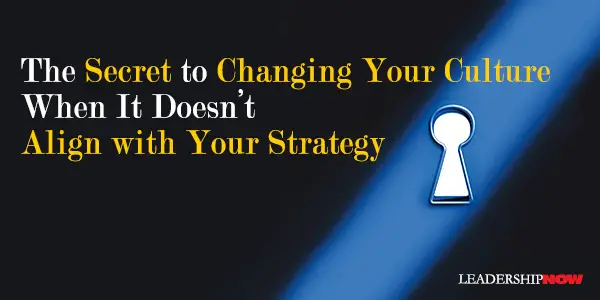 |
 |
08.08.23

The Secret to Changing Your Culture When It Doesn’t Align with Your Strategy
IF YOU WANT to change your culture, you need to change the stories that the people in your organization share with each other. Jay B. Barney, Manoel Amorim, and Carlos Júlio write in The Secret of Culture Change that these culture-changing stories are the secret of culture change. If you want to change your organization’s culture, start by building stories. By interviewing leaders who attempted to change their organizational culture, they collected over 150 culture-changing stories, many of which found their way into this book. From these stories, they identified six attributes of successful culture-changing stories. They go into detail to explain the six attributes of successful culture-changing stories. The stories and organizational myths that they share in each chapter are not only engaging and entertaining but instructive and worth the price of the book alone. The six attributes are: 1. The actions that these stories are built on are authentic. Authentic stories “reflect your deeply held values and beliefs about who you are as a leader, your commitment to the well-being of your employees and other stakeholders, and how these are related to the ability of your firm to implement your strategies.” 2. These stories “star” one leader. This is not to gratify your ego but to demonstrate your commitment by being the culture to want to change to. “If you are not willing to do something that will build a story in your firm to help change its culture, then it is very unlikely that your employees will believe that you are truly committed to culture change.” 3. The actions that build these stories signal a clean break with the past, with a clear path to the future. “The stories you build to change your organization’s culture have to make it clear what specific patterns of thinking, acting, and responding are no longer acceptable, and what these new patterns will be.” The story must break with the past and show a path to the future. 4. These stories appeal to employees’ heads and hearts. “Successful culture change requires both an appeal to the rational economic interests of your employees—their heads—and to their emotional and social interests—their hearts.” 5. The actions that build these stories are often theatrical. By theatrical, they mean doing something that is outside the normal in a public setting that reinforces some aspect of the cultural change. 6. These stories are told and retold throughout an organization. Stories that are “authentic that star you, that identify a clear break with the past and a path to the future, that appeal to both head and heart, and that are theatrical in nature” begin the culture-change process. The trick, then, is to enlist other members of your organization to create their own culture-changing stories or what the authors call a story cascade. The leaders profiled in this book “found the basic materials needed to build a story when their expectations about what their organization needed to do were inconsistent with what it was actually doing. Every time you become aware of a time when your organization does not deliver on its strategy, there is a possible culture-changing story there.” 
Posted by Michael McKinney at 08:24 AM
|
BUILD YOUR KNOWLEDGE
 

How to Do Your Start-Up Right STRAIGHT TALK FOR START-UPS 
Grow Your Leadership Skills NEW AND UPCOMING LEADERSHIP BOOKS 
Leadership Minute BITE-SIZE CONCEPTS YOU CAN CHEW ON 
Classic Leadership Books BOOKS TO READ BEFORE YOU LEAD |